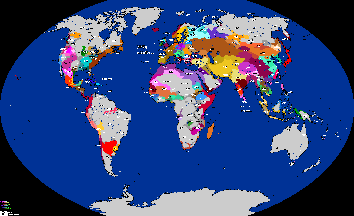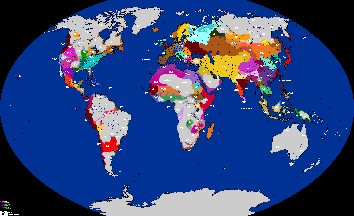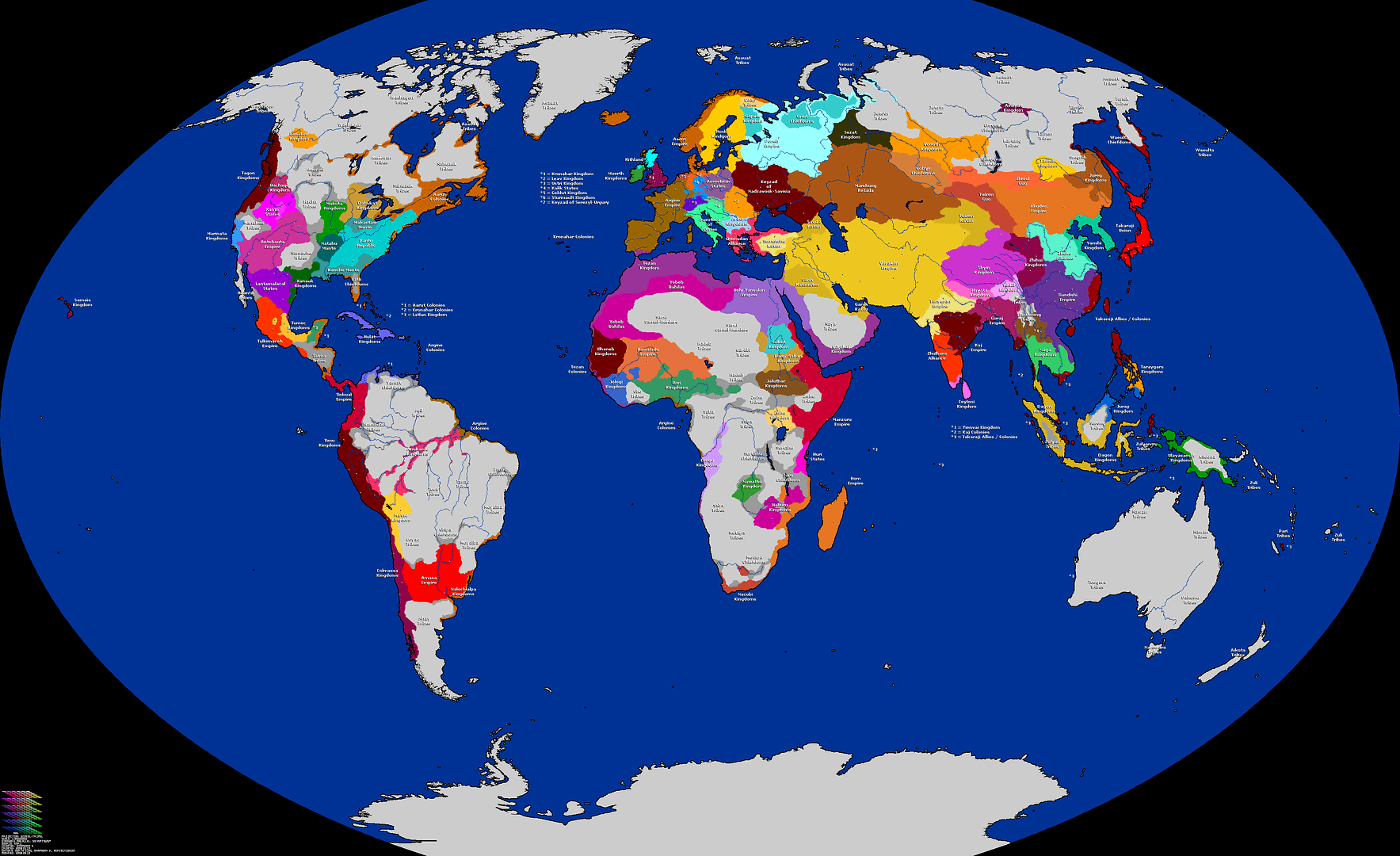EUROPE:
As the young Emperor Erikus takes to the throne of Aarut, the great Empire embraces a new constitution, offering more liberty and representation for different provinces. In 1795, the people of Lanverg happily become part of the greater empire, as Aarut inherits that crown through royal marriage. The failure in Nayota is hardly noticed at home, as other colonies continue to expand, and the strongest fleet in Europe ensures a steadily flow of goods to and from the home ports.
Rosk goes through similar reforms and finally unites with the Thelsing Kingdom in 1777. Both peoples remain on good terms with Aarut, and each other.
Leav temporarily and peacefully annexes the Geldut kingdom from 1780-1792. Independence is restored following civil unrest, but the two states remain allies.
Taretara and Tezan fight several times. Several abortive invasions are made by both sides across the straights of [Gibraltar]. Taretara gains influence in the [Caribbean], while Tezan gains all the islands near Africa and more colonies on the African mainland.
The Saratian Empire is finally dissolved and mostly absorbed into the Orimudian sphere. Other territories pass to the Ketada.
Civil war takes place in Kronahar. While privateers achieve mixed results overseas, a pro-trade government takes shape at home. More territory is exchanged throughout Graeland [Britain], as a result of civil wars and diplomacy. The Aarut agree to withdraw from most of northern Rithland [Scotland].
For the cause of Targoratan unity, Kilamys is annexed by Argine Empire. Some islands (in particular, the rest of the [Azores]) pass to Kronahar as part of the agreement.
Countless other wars are fought, none of them major. Tensions build up between the main power blocs as the decades pass. In 1792, the Argine Empire annexes Taretara, mostly peacefully, although the old trade routes begin to suffer, and civil unrest increases. Around the same time, a powerful alliance of Amestrian states led by Sturmault rises to power in the east, galvanised in defence against Rosk and Leav in the north, and the ambitious Keyzad of Nadzvadosk in the east. And in the south, thanks to the influence of the philosopher-statesman Murio Setvacco, the Curias Kingdom becomes leader of a loose ‘Furotocan’ [Democratic] empire including Mutyl [Italian] and Kalik [Balkan] lands, known as the Furotoca of Curias, which spends its first decades dealing with constant ethnic and political unrest.
The ‘axis of learning’ grows to include Aarut. The greatest technical achievements in machinery, metallurgy and chemistry are made in Curias, but the greatest practical gains are made by the Aarut, who have abundant coal, timber and metal ores to fuel their experiments with early industry – spurred by the great demands of building, arming and repairing a vast number of ships for their navy. Meanwhile the Amestrians debate philosophy, politics and military doctrine.
AFRICA AND THE MIDDLE-EAST:
Some fairly major wars are fought between native African powers, especially in the west, as muskets and cannons begin to arrive from foreign arms merchants.
The Holy Yansalan Empire continues to fade. While still an official vassal of Yansala, the King of Tezan gains more land and more official titles, stopping just short of declaring himself divine Emperor.
The trade with Taretara begins to decline after its annexation into the Argine Empire. The Nacubi states of the [South African] coast also go into decline. Tezan is able to make more inroads into west Africa, and maintains trade with the [Carribean] despite the loss of its colonies there.
Following the conquest of more territory in mainland Africa, the Hom Empire enters another period of civil war.
The Manzuru Empire also begins to overextend itself as it moves in on the lower [Nile]. Manzuru’s plotting and scheming eventually do more to unite their enemies than divide them. But there is also more trade with India, the Varakan Empire and East Asia. This trade has an enlightening influence on Manzuru.
INDIA AND CENTRAL ASIA:
Zhul pirates plague the Indian Ocean and [Indonesia].
The Zhulharasa states are united into a single entity, under pressure from their powerful neighbours. The Kaj and Guraj Empires constantly duel with each other and slowly spiral into decline.
Poneb and Marzhung fight several devastating wars with each other. Allies are brought in on both sides. Former vassals and allies switch sides – the best general of the Ponebian side is Dezov Taraskalic, from the Keyzad of Nadzavosk. The Marzhung burn several cities and commit many massacres. Poneb eventually gains the most ground, thanks to more modern firearms, but is left exhausted and bankrupt. And the Marzhung Empire, despite attempts at reform, becomes divided into factions as a result of the wars, but gains influence over the northern Sezat lands and other eastern steppe peoples, with the exception of the hostile Vonoth kingdoms.
Meanwhile the idea of ethnic-Sarvonian unity begins to spread. The Ketada of the Nadzavosk and Savisia unite in 1811. But as a result of previous wars against Amestrians and Marzhung, this new power has only the Poneb as its only ally.
The Varakan Empire enters the 'Akao Do’ (good times), a new golden age. Faltering vassals and allies are annexed into a huge empire. More vassals are gained along the frontiers. Imperial envoys travel across Eurasia. Science and learning flourish, as does trade. The standard of living of the Empire’s upper classes is the envy of the world. The army is also modernised, and many wars are fought.
Relations with the Marzhung deteriorate in the late 1790’s, but the attentions of both sides are elsewhere. In the few short wars that do occur, Varakan armies again show that traditional steppe horse-and-bow tactics can no longer stand alone against massed mobile firepower.
Varaka puts great emphasis on science and learning. The technology of the Empire is a mix of old and new at this time - in some ways ahead of the rest of the world, particularly in mining, irrigation, weaponry and medicine. But much of the Empire remains poor, with the way of life little changed since ancient times. The great variety of climates, cultures , religions and customs tends to work against the spread of modern innovation. Nonetheless the great cities – especially those in the west – are havens for technological progress.
EAST ASIA:
The remote Asalyat civilization rises from [Siberia], born from a mix of Asuat peoples and other natives.
The Zhihui Empire, never managing to match the prestige of the old Tuizen powers, crumbles into civil war and smaller kingdoms. The religious autocracy of Shyin begins to absorb them.
In the small, besieged kingdom of Tiandishi, this is the time of certain legendary figures who would have great influence for centuries to come. The ambitious King Huangwin, working with his able ministers Ying Yu and Wang Dong, introduces the idea of ‘zhenzheng’ [realpolotik]. In just a few decades, Tiandishi gains control of the larger Yulashisi kingdom in the south, and the support of the Mingdebuist majority. King Huangwin’s descendents continue to skilfully exploit the situation, until by 1820 the kingdom is an Empire once again - strong enough to keep out Takariji, but behind in technology, and with a little too much power in the hands of fanatical Mingdebu militias.
The once-mighty Yeuren alliances are humbled by Akuden invasions and economic troubles. The Zhuko dynasty attempts to rebuild things from the city of Wusung, while coastal cities unite with the Yanshi Kingdom for protection.
However, Yanshi ambitions remain unfulfilled, as Takariji dominates the Pacific coast with a large fleet, and gains more land and influence for its vassal states. Takariji influence spreads as far as Africa and the Middle-East. But as treasuries increase, the Takariji leaders struggle to maintain overall authority. Waeluta peoples are given greater freedom in the far north islands, in the hope of preventing them conspiring with rival Asian powes. The Takariji lose interest in Australia, but regular trade expeditions are sent to America from Samaia [Hawaii].
Several uprisings hoping to create a religious (Mingdebuist) republic in Dagon [Indonesian] lands are all defeated by the traditional rulers, with the help of the Takariji fleet.
Yanshi and Takariji continue to push science and technology, and roughly on a par with Europe at this time. As in Europe, the demands of shipbuilding and maintenance inspire many of the early industrial innovations.
)









 . Rest assured, my page-long orders will make a comeback after this update.
. Rest assured, my page-long orders will make a comeback after this update.